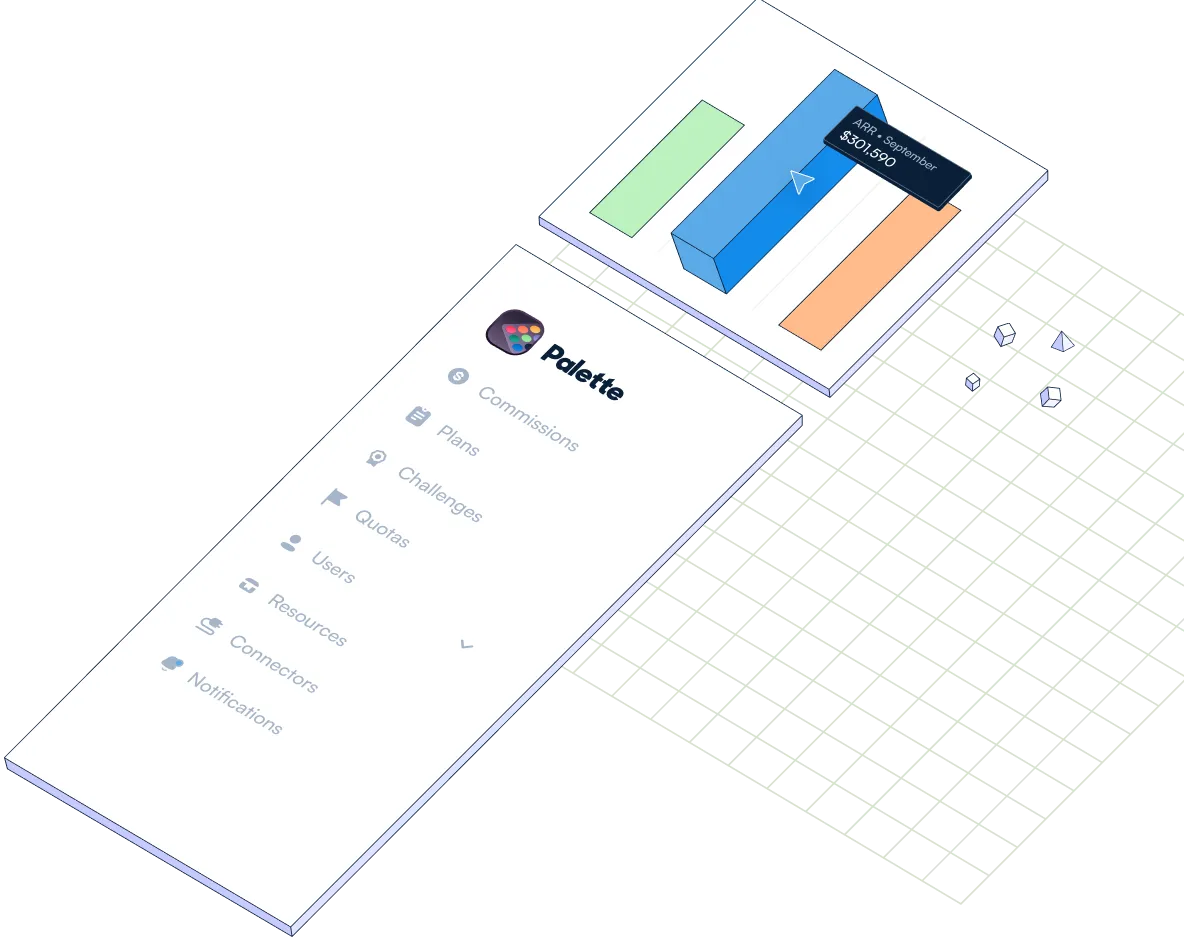Types of CSM Compensation Structures
Incentives and compensation models for customer success teams often vary significantly across companies and industries. On one end of the spectrum, customer success managers, or CSMs, are purely in a partner role with customers, helping them get the most value out of the products and services they have purchased. On the other end, customer success managers often work closely with sales teams, have a significant focus on upselling customers, and may even have a large percentage of their total earnings come from variable compensation, although not as large of a percentage as sales teams have. In determining how to map out compensation for customer success teams, it’s essential to design a structure that accounts for the specifics of each business and will maximize outcomes in line with your specific business objectives. This guide will break down the fundamentals of CSM compensation and explore the trade-offs and use cases for each model, with a particular focus on metrics, renewals and expansion, and revenue growth.
At the most basic level, there are three basic models for compensating customer success teams:
Compensate CSMs with a Base Salary
This is the starting point for any CSM compensation package. By itself, this is the simplest way to compensate CSMs. This structure can make a lot of sense for certain types of businesses.
For example, new CSM teams without any historical performance data or benchmarks around upsell potential. The responsibilities and focus areas for CSM teams can be broad, and without an understanding of where they will be most effective, providing solely a base salary in the early years can be helpful while establishing where to focus the efforts of the customer success team. Similarly, this can also be helpful for teams where there is a huge backlog of work which may not be directly related to driving revenue, or where product adoption is suffering to the point where CSMs have to do damage control before focusing on revenue growth.
The benefits of this structure:
When CSMs are needed to be a neutral, strategic advisor, a base salary helps ensure their neutrality. This can be helpful for earlier stage companies still looking for product market fit; churn events can be a natural course of action as a company tries to figure out who its best customers are, and having CSMs proactively churn customers which just don’t make sense is an important tool. Thus, incentivizing CSMs to not churn customers would be counter to the company’s best interests in this scenario.
The downside to this structure:
CSMs can often become focused on lower impact or even reactionary work, and have less incentive to be laser focused on revenue growth or specific product adoption metrics. Some customers will always use CSM resources as much as they can get away with; with this compensation model, it can be more difficult for CSMs to extricate themselves from requests which aren’t always mission critical.
For companies with newer customer success teams who pursue this approach, it can be helpful to think about if or when it might make sense to move towards a compensation structure incorporating some level of variable compensation, and setting expectations with the team as new hires are onboarded in order to ensure a smoother transition.
Compensate CSMs with a Base Salary + Bonus
This next compensation model for customer success teams begins to add in some financial incentive towards revenue goals. In this scenario, the majority of the CSMs earnings will still come from their base salary, but quantitative achievements such as renewals or upsells become more of a focus. This helps customer success teams stay more focused on revenue metrics throughout the year.
With this approach, the bonus is often tied to team goals. Collaboration is important to help customer success teams be effective, as they can share learnings with issues faced from different types of customers and resolve issues more quickly.
For customer success teams that have not historically had any form of variable compensation and want to begin implementing it but are apprehensive about the cultural impact, this approach can help share the burden across the team and serve as a smoother transition versus moving directly to a bonus tied to individual goals.
However, the downside to this approach is that it may not adequately reward CSMs who go above and beyond in order to retain or upsell large or difficult customers. This can create resentment, especially in situations where a CSM is working with a sales rep to upsell an existing account, and the CSM might do an outsized proportion of the work for a relatively small bonus while the sales rep might benefit significantly more from variable comp once the customer upgrades.
Compensate CSMs with a Base Salary + Variable Compensation
This tends to be the best compensation model for customer success teams that want to drive revenue growth. With this structure, the CSM still earns a base salary, but a higher percentage of their earnings comes from variable compensation tied to revenue goals such as renewals, upsells, and cross-sells, or related metrics such as product adoption or product usage.
What’s the right OTE split for CSMs?
Generally speaking, customer success OTEs range between a 70/30 split and an 80/20 split between base salary and variable comp. For example, if the CSMs on-target earnings, or OTE, is $100K, then $70K would be their base salary and $30K would be their full variable comp earning potential.
When over 30% of comp is variable, the position starts to become closer to a sales compensation structure, and incentivizes revenue growth above ensuring the customer is adequately supported and set up for success in the long run. Meanwhile, when the variable comp is under 20%, the incentive to grow revenue tends to be too small to motivate the most effective set of behaviors from CSMs.
Variable on retention vs. growth: the next question that arises is how to split CSM variable compensation between retention goals and growth goals. This will depend on each company’s churn rate, NRR, and past success upselling or cross-selling customers.
7 Factors Which Should Shape Your CSM Commission Structure
Designing commission plans for customer success teams is complex and requires careful consideration of your business, product, and team. Unlike sales teams, standards for CSM comp structures vary wildly even within the same industry. This is due to the different activities, skill sets, and actions that CSMs are involved with, sometimes even within the same company. This guide provides a thorough list of variables to consider which can help you optimize the way you compensate CSMs.
The length of your sales cycle
The average length of the sales cycle is an important consideration in determining how to allocate responsibilities between customer success and sales team in areas where there may be overlap. Companies with shorter sales cycles may find it more beneficial to have CSMs own quotas for renewals and expansions. Meanwhile, companies with longer sales cycles and stronger relationships between AEs and customers might prefer to involve sales in these areas.
The size of your product portfolio
For companies with wide and complex product portfolios, it may make sense to have a sales rep and a customer success manager work together on expansion opportunities. In these situations, the CSM can bring valuable knowledge about the inner workings of these various products and how they apply to the customer’s implementation. Meanwhile, the sales rep can help ensure that revenue potential is realized. Together, these roles can help ensure the best outcome for the customer while contributing to revenue growth.
Churn rates
Customer success is a complex role which requires attention to several different KPIs and customer health scores. Churn is a complex issue requiring the attention of all departments of a company. However, CSMs can take steps to help reduce and manage churn rates. For companies with high churn rates, it may make sense to have CSMs focus more of their attention on successful implementations, helping customers realize value from the product, and driving customer adoption. In these cases, giving CSMs quotas for expansion and cross-selling may be distracting from more important goals.
CSAT Scores
Understanding customer health through metrics like CSAT scores can help determine where CSMs need to focus, and thus, what behaviors it makes sense for your business to incentivize. For companies with high overall CSAT scores, it can be helpful to look at what areas are driving customer satisfaction to determine if there are upsell or cross-sell opportunities; these can become part of CSM variable compensation plans. Meanwhile, companies with lower CSAT scores may be better off incentivizing CSMs to address these areas while working cross-functionally within the company to solve underlying issues such as product issues.
Historical Revenue
Expansion Performance Understanding how revenue expansion has occurred in the past can help set benchmarks for future performance and provide direction when a change of strategy is needed. What teams have been successful at revenue expansion in the past? Is it worth doubling down on past success? If revenue expansion has not been successful, what are the underlying reasons why? To understand this, it may be helpful to speak with customers to understand what prevented them from purchasing, to address the root cause of the problem. If the product meets customer needs but they still aren’t purchasing, it may be a pricing or competitive issue.
The Size and Scope of the Customer Success Team
Customer success teams are unique in that they require a number of different skill sets. Some CSMs are technical product experts, some excel at customer relationship building, and others may have strong sales skills. Different CSMs have different strengths, and being honest about what skills there are on your team is important in determining if it is feasible and realistic to assign CSMs revenue growth quotas. Where there are a few individuals on the customer success team who are adept at sales, it can help to set a team quota and incentivize individuals on knowledge sharing within the team. In other cases, it may help to hire CSMs who are focused on expansion and assign those individuals quotas.
Your Customer Segments
Customer profiling, demographics, and psychographics are important considerations when designing incentive plans for CMS. Understanding customer preferences around interactions, support ticket requests, response times, and more can ensure that customers are set up for success. These preferences can vary wildly between different industries, geographies, and company sizes, so taking them into account is important as you set goals for your customer success team.
There is no one size fits all structure for CSM compensation; the approach varies based on your unique business. To create the best CSM comp plan, take the nuances of your business into account and be sure to look at historical data and past performance to determine the best approach.
Why Palette?
Automate calculations
Automate sales commission payments. Create commission rules, define a payout schedule and access monthly statements for each sales rep.
Motivate and coach with real time dashboards
Motivate sales professionals with real-time visibility into commissions. Coach your team, align everybody with company goals and drive long term sales performance.
Compare, simulate and design commission plans
Roll out new commission plans with ease. Compare plans and simulate new rules with a single click.
No more errors
Palette keeps history logs and tracks every calculation detail, helping you to reduce sales commission errors.
Reconcile revenue with CRM data
With Palette you can reconcile invoices and payments with CRM data and pay commissions to your reps only when the money is in the bank.
Create challenges with one click
Incentivize your teams on short term goals. Create a challenge targeting any KPI you want to uplift, drive better results and boost your company’s culture.

Loved by teams and companies you know

















Ready to try
Palette?
